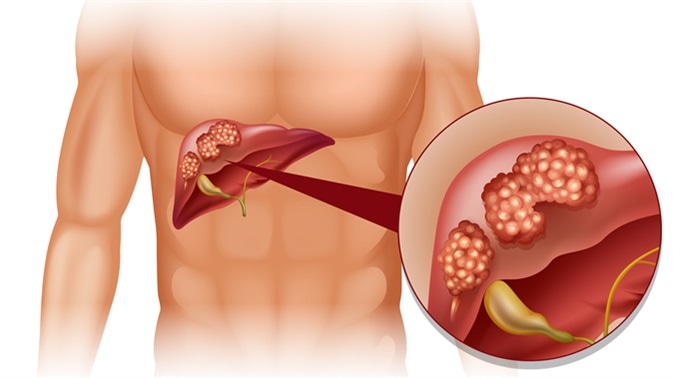Secondary liver cancer is a condition in which primary cancer cells have spread to the liver. Cancers such as bowel cancer, lung cancer, and breast cancer can spread to the liver. For example, when an individual has lung cancer and cancerous cells extend to the liver, the liver cancer comprises cancer cells that are from the lungs.

Liver cancer in human illustration.
Image Credit: BlueRingMedia / Shutterstock
Managing symptoms
The intensity of symptoms experienced in secondary liver cancer may vary across individuals; in fact, not all individuals will even report experiencing symptoms.
A common symptom reported by secondary liver cancer patients is extreme fatigue. Everyday life becomes difficult and a feeling of sickness is experienced. Devoting additional time to doing daily tasks and taking help from others may help. If the current treatment for the sickness is not found to be effective, discussing the symptoms with physicians and identifying the cause of the sickness may help to arrive at an effective treatment.
Eating meals in small quantities frequently instead of a big meal has been reported to help manage loss of appetite. The type of food that a patient is eating may not be considered; therefore, he/she can eat what is preferable to them. When the patient avoids food, it is recommended that high-energy drinks are instead consumed.
In some patients, the abdomen is swollen due to the accumulation of fluid. Conditions such as a blockage of lymph glands in the abdomen may prevent the fluid from draining. In addition, when cancer spreads to the liver, it can increase the pressure in the adjacent blood vessels, thus forcing the fluid to move out. When the liver is unable to produce sufficient blood proteins, the fluid starts leaking from the veins into the abdominal cavity.
When the abdomen is swollen, physicians can insert a needle into the abdomen to drain the abdominal fluid (ascites) with the help of a tube. Otherwise, the fluid may build up once again. In some cases, the physician will insert a permanent internal tube into the abdomen for draining the fluid.
To control pain, physicians prescribe pain killers.
When the cancer affects large portions of the liver or if there is a block in the bile duct, jaundice may occur. Jaundice can present as a yellowing of the white portion, or sclera, of the eye, as well as the skin. Additionally, jaundice can also cause stool to appear white or pale in color. In order to correct jaundice, physicians may insert a bile duct to remove blocks from the bile duct.
When the liver presses the chest nerve, hiccups may occur. Drugs are available to control hiccups.
As the liver helps in controlling body temperature, extreme temperatures may affect patients, thereby causing them to feel extremely cold or hot.
Treatment
Treatment for secondary liver cancer includes removing tumors, reducing the size of the tumor, or controlling symptoms.
For patients undergoing intrahepatic chemotherapy, a catheter, which is a thin tube, is inserted into the main artery that leads to the liver. Chemotherapy is provided with the help of a small pump that is placed near the liver. The duration of the treatment varies depending on the requirements for each patient.
In hepatic artery infusion (HAI), a higher concentration of medicine is used for treating the tumor. In another similar process, transarterial chemoembolization (TACE), along with the chemotherapy drug, involves the use of an oily liquid or a gelatin sponge that can be absorbed is given to the patients. The drug mixture prevents the flow of blood, oxygen, and nutrients that the liver receives while damaging tumor cells. As the drug mixture resides in the tumor area for a substantial amount of time, the cancerous cells receive a high-dosage drug treatment.
During radiotherapy, high-energy waves are used to destroy cancer cells. The therapy is used for controlling symptoms such as pain and the further growth of the cancer cells. However, radiotherapy is not recommended for liver cancer, as the liver is very sensitive to this treatment.
In selective internal radiation therapy (SIRT), a catheter is inserted into the hepatic artery, which supplies blood to the liver. Through this tube, physicians send small beads known as microspheres, which surround the tumor area by getting stuck in the nearby tiny blood vessels.
The microspheres, also called SIR-spheres, use the radioactive substance yttrium 90, which provides the dosage of radiation to the tumor. In addition to causing damage to the cancer cells, the radiation also interrupts the blood supply to the tumor, which makes the tumor nutrient deficient (radioembolization process).
Although the radiation from the microscope affects a region of about 2–3 millimeters (mm) around the trapped tumor, the extent of damage to the healthy tissues that surround the trapped area is much less. The harmless microspheres reside permanently in the liver and, within two weeks, the radiation moves away from the microspheres.
Treatments such as the injection of alcohol, laser therapy, and microwave ablation are used to destroy cancer cells. In cryotherapy, cancer cells are frozen.
In radiofrequency ablation, radio waves are used to destroy cancer cells, whereas in radiofrequency-assisted surgery, radio waves are used to destroy the cancer cells and remove them from the patients.
References
Further Reading
Last Updated: Feb 17, 2023